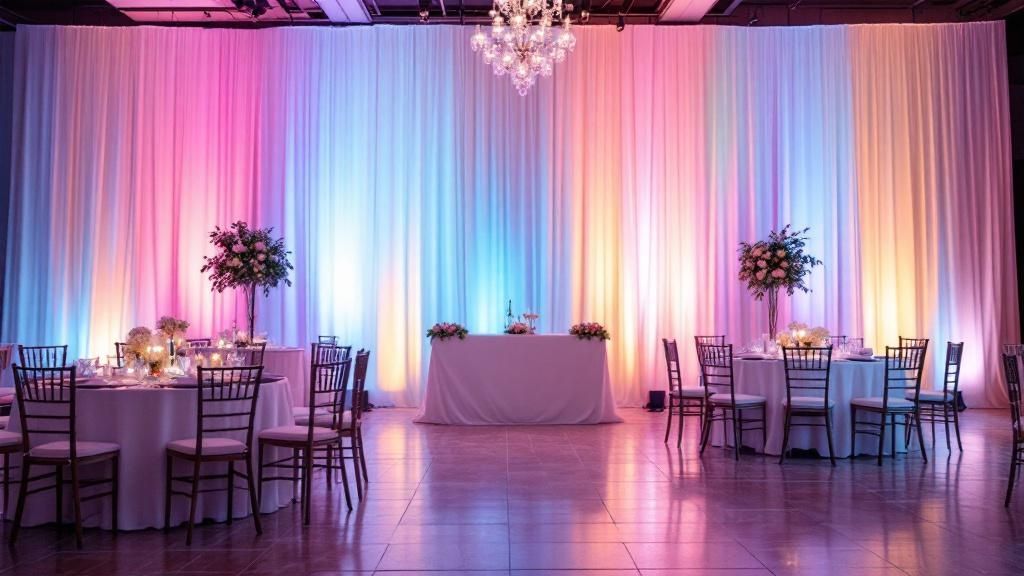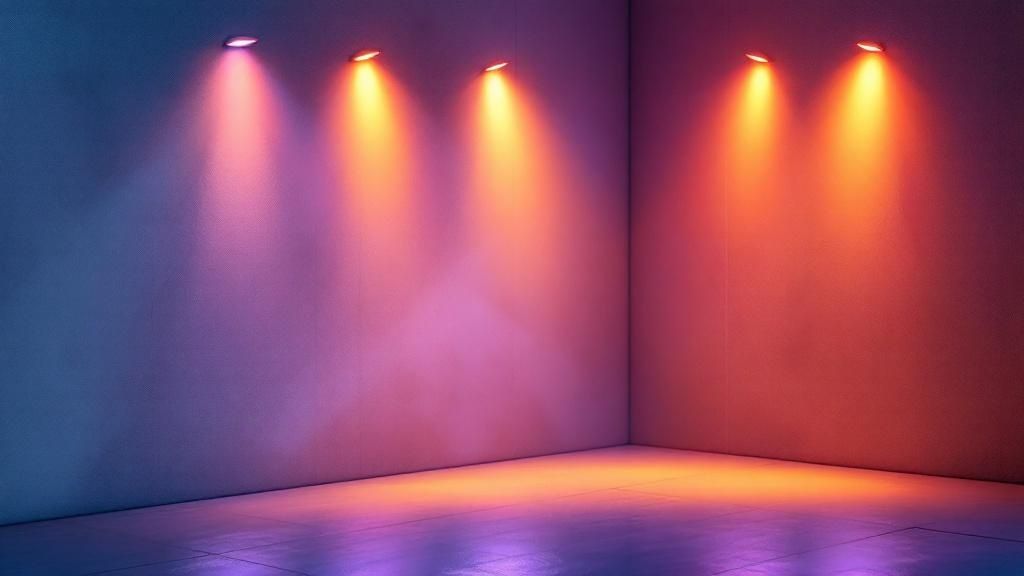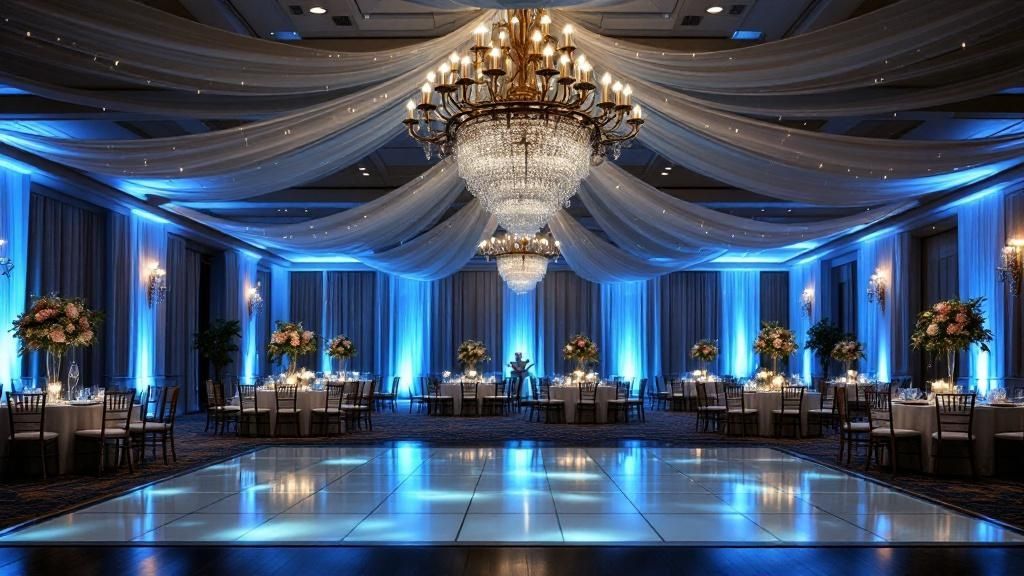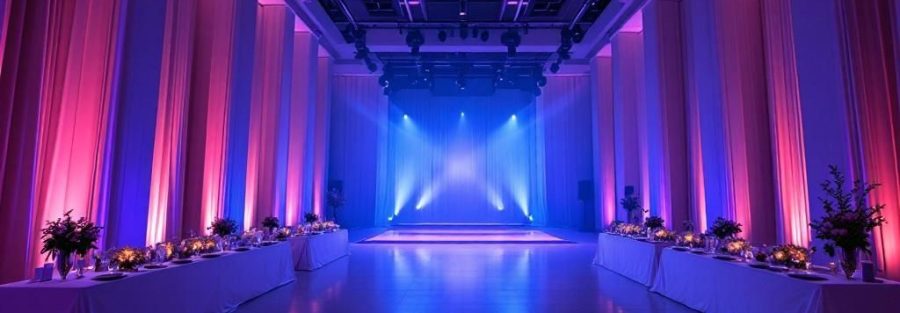Ever walked into a wedding reception and just felt… wow? Chances are, the secret ingredient wasn't just the flowers or the cake, but the lighting. Specifically, uplighting for a wedding reception. This is more than just flipping a switch; it's about using light to paint the room, create a specific vibe, and turn a nice venue into a breathtaking one.
The Secret to a Breathtaking Reception Atmosphere

Uplighting is hands-down one of the most powerful tools you have for setting the emotional tone of your party. It’s all about placing lights on the floor and aiming them up, washing walls, columns, or other cool features in pillars of colored light. The effect is dramatic and immersive in a way that standard ballroom chandeliers just can’t touch.
Picture this: during dinner, the room is bathed in a soft, romantic amber glow that makes everyone look fantastic. Later, as the first dance ends, the lights shift to vibrant, energetic colors, signaling to everyone that it's time to hit the dance floor. That's the magic of uplighting.
Highlighting Your Venue’s Best Features
Every venue has its own personality, and uplighting is how you bring it out. Think of it as your personal spotlight for the room's best assets.
You can use it to:
- Showcase Architecture: Got cool columns, dramatic archways, or interesting textured brick? Uplighting makes them a star feature instead of just part of the background.
- Frame the Important Stuff: Create a visual anchor around your sweetheart table, the cake display, or the dance floor, drawing everyone's eyes right where you want them.
- Make Your Decor Pop: That gorgeous floral centerpiece or carefully chosen linen? A wash of light makes the colors richer and the textures deeper.
This adds so much depth and dimension, keeping the space from feeling flat or one-note. The right lighting plan can make a simple room feel absolutely grand or turn a massive ballroom into an intimate, cozy space. For a deeper dive into the basics, check out our guide on what is uplighting for weddings.
Setting the Mood from Dinner to Dancing
The best part about modern uplighting is that you're not stuck with one color all night long. The real pros can program the lights to evolve with your reception, guiding the energy from one moment to the next.
The right lighting does more than just illuminate a space—it creates an experience. It's the silent storyteller of your wedding day, shaping how every moment feels and ensuring your photos are as incredible as the memories you're making.
It's no surprise that dynamic lighting has become a huge deal. In fact, some reports show that up to 60% of weddings in major cities now use some form of advanced lighting. The trend is only growing, with more couples looking beyond simple uplights to things like hanging installations and pin spotting. It just goes to show how critical lighting has become.
To help you visualize how these choices play out, here’s a quick breakdown of what different lighting elements can do for your reception.
Uplighting Impact at a Glance
| Element | Impact on Your Reception | Pro Tip |
|---|---|---|
| Color Choice | Sets the core mood. Warm ambers/golds feel romantic; cool blues/purples feel modern and chic. | Start with a soft, warm color for dinner and transition to more vibrant hues for dancing to change the energy. |
| Light Placement | Creates depth and highlights architectural details. Spacing lights 8-10 feet apart gives a full, even wash. | Focus lights on columns, fireplaces, or the wall behind your head table to create stunning focal points. |
| Dynamic Changes | Transitions the event from elegant dinner to high-energy party. | Have your DJ or lighting tech sync the lights to the music during the dancing portion for a true concert vibe. |
| Intensity (Dimming) | Controls the intimacy of the space. Softer light feels more personal and romantic. | Keep lights brighter during introductions and toasts, then dim them down for slow dances to create a magical moment. |
Ultimately, great lighting is about making intentional choices. By thinking about color, placement, and transitions, you're not just decorating a room—you're designing an unforgettable experience for you and your guests.
Choosing Uplighting Colors That Tell Your Story

Okay, this is where the real fun begins. Picking your uplighting colors is how you inject your personality into the venue. It’s about so much more than just matching your color palette—you're literally painting with light to create a vibe, an emotional experience for everyone who walks through the door.
The right hue can make a huge room feel intimate and warm, or it can dial up the drama for a high-energy party. It sets the backdrop for everything, from the quiet, teary-eyed toasts to the moment the dance floor explodes. This is your chance to tell your story with color.
For a Timeless and Romantic Vibe
If you're dreaming of a classic, hopelessly romantic atmosphere, you just can't beat warm tones. Not only are they stunning, but they're also incredibly flattering in photos, giving everyone a healthy, happy glow.
- Warm Amber: This is the gold standard for that "candlelit dinner" feeling. It instantly makes a space feel cozy and inviting. I've seen it transform cavernous ballrooms into intimate settings where guests feel comfortable and ready to mingle.
- Soft White: A beautifully clean and elegant choice. It adds a sophisticated glow without competing with your other decor. It works seamlessly with things like chandeliers or actual candles, creating a look that's pure class.
These are fantastic options if you want your flowers and table settings to be the main color story. The lighting just supports it all, wrapping the room in a warm hug.
Modern Romance and Dramatic Flair
Now, if your style is a bit more contemporary, or you just want to make a bigger statement, this is where you can get creative. Cooler tones and bolder colors can completely transform a room into something your guests will talk about long after the wedding.
Here's a pro tip: Don’t feel locked into just one color for the whole night. The best events often transition the lighting. Start with a soft, elegant color for dinner, then switch to something more vibrant to get the party started.
For example, a delicate blush pink can pull out the tones in your floral arrangements, creating a modern, romantic feel that’s soft but still very intentional. For a more dramatic, evening-luxe look, think about deep blues and purples. A rich sapphire blue can create a dreamy, starry-night effect, while a deep purple adds a touch of royal luxury and drama.
We dive deeper into pairing these shades in our complete guide to uplighting colors for your wedding.
Ultimately, you want colors that feel like you. A popular and safe bet is an elegant white, which blends with everything. But I've seen so many couples have fun with this—using blush pinks for romance or moody purples to accent a cozy seating area.
Then, when it’s time to dance, switching to vibrant blues and purples can instantly flip the switch to a fun, club-like atmosphere. It’s this smart use of color that makes uplighting for a wedding reception more than just light; it becomes a key part of your design.
Where to Place Your Lights for Maximum Impact
Alright, let's talk placement. Getting the placement right for your wedding reception uplighting is just as crucial as picking the perfect color. Honestly, where you put the lights is what separates a decent lighting job from a truly breathtaking one. You're essentially painting with light, guiding your guests' eyes and creating a mood.
Before you even think about plugging anything in, take a slow walk around your venue. Get a feel for the space. I always tell my clients to look for the "money spots"—those unique architectural details that give the room its personality.
- Structural Columns: Got pillars? Perfect. A light at the base of each one creates these incredible, soaring columns of color that add so much height and drama.
- Unique Wall Textures: If your venue has gorgeous exposed brick, cool stonework, or even elegant drapery, washing it with light will make those textures pop beautifully. It adds a ton of depth.
- Window Frames: Placing lights to frame large windows is a great touch. It creates a soft, beautiful glow, which looks especially stunning as it gets darker outside.
Creating Pillars of Light vs. a Color Wash
Now, how far apart should you space your lights? This is a big decision because it creates two completely different looks.
If you want those distinct, dramatic pillars of light reaching up the walls, you’ll want to space your fixtures farther apart. A good rule of thumb is about 10 to 15 feet between each light. This is a classic, elegant effect.
On the other hand, if you're dreaming of a seamless color wash that bathes the entire wall in a single, vibrant hue, you'll need to place the lights much closer together. We're talking about 5 to 8 feet apart for this. It takes more lights, for sure, but the result is a really immersive, high-energy atmosphere.
Pro Tip: Think about the key moments of your reception. Strategically place lights to frame your sweetheart table, the cake display, or the dance floor. This makes sure those all-important spots really stand out, both for your guests and in your wedding photos.
Avoiding Common Placement Mistakes
It’s easy to get excited and just start putting lights everywhere, but a little restraint goes a long way. The most common mistake I see is creating weird, unintentional shadows. For instance, putting a light directly behind a big floral centerpiece might cast a bizarre, spidery monster of a shadow on the ceiling. Not exactly the vibe you're going for.
Another huge thing to consider is foot traffic. Never, ever place lights or cables where people will be walking. You don't want your grandma tripping over a power cord.
This is where modern, battery-powered wireless uplights are an absolute lifesaver. They completely eliminate tripping hazards and give you the freedom to place them literally anywhere, since you aren't chained to the wall outlets. It’s the key to a design that's not only gorgeous but also safe for everyone there to celebrate with you.
DIY Uplighting vs. Hiring a Lighting Pro
So, you're sold on uplighting—fantastic! Now comes the big decision: do you tackle it yourself or bring in a professional? This is a classic dilemma for couples, boiling down to a trade-off between your budget, your time, and how ambitious your lighting vision really is.
Honestly, there’s no single right answer. Your choice really depends on what you value most: saving some money or having total peace of mind.

Going the DIY Route
The do-it-yourself path is incredibly popular, and for good reason—it’s the most budget-friendly option. This means you’re renting the lights and taking charge of the entire process. You’ll be responsible for picking them up, setting them up before guests arrive, and, yes, tearing it all down at the end of the night.
If you’re leaning this way, make your life easier by insisting on battery-powered LED uplights. Seriously, this is a non-negotiable. It saves you from the nightmare of taping down miles of extension cords and worrying about guests (or Grandma) tripping over them.
Before you rent, get on the phone and ask some key questions:
- How long will the batteries last? You need at least 5-8 hours of solid runtime.
- Are all the lights from the same manufacturing batch? This sounds nitpicky, but it’s the secret to consistent color.
- What’s your policy if a light is dead on arrival or fails mid-reception?
- Is there a simple remote included for setting the colors?
The biggest hurdle with DIY is the manual labor on a day when you’re already stretched thin. You’ll need to get to the venue early, figure out the best placement for each light, and sync them all to the same color. It’s definitely doable, but it’s one more thing on your plate.
Bringing in a Lighting Professional
Hiring a professional is less about renting equipment and more about buying expertise and freedom from worry. A good lighting designer doesn’t just place lights around a room; they paint with light to create a mood and an experience. They arrive with high-end, perfectly maintained gear that produces richer colors than most rental units can.
This is where the magic happens. A pro can program dynamic lighting changes throughout the evening. Imagine a warm, romantic amber glow during dinner that smoothly transitions to vibrant, beat-thumping colors when the dance floor opens up. That’s the kind of thing a professional delivers.
They also bring a designer’s eye, knowing just how to use light to draw attention to your cake or hide an unsightly service door. All the technical stuff—power draws, wireless DMX controllers, and troubleshooting—is their problem, not yours. Taking a look at professional event lighting rentals will show you the difference in equipment and service quality.
The real value of a pro isn’t just the gear. It’s their experience. They know how that beige wall will change the hue of your chosen blue. They see problems before they happen and handle every last detail, so you can just enjoy your party.
DIY vs Professional Uplighting Comparison
To help you decide which path is right for you, I’ve put together a quick head-to-head comparison. This should make it clearer where your priorities lie.
| Factor | DIY Uplighting | Professional Service |
|---|---|---|
| Cost | Lower initial cost. You're only paying for the equipment rental. | Higher investment. You're paying for gear, labor, design, and expertise. |
| Effort & Time | High. You are responsible for pickup, setup, troubleshooting, and teardown. | Zero. The company handles absolutely everything from start to finish. |
| Equipment Quality | Good to average. Rental-grade lights, which can have color inconsistencies. | Excellent. High-end, commercial-grade fixtures with perfect color matching. |
| Creative Control | Basic. You can set static colors, maybe a slow fade if you're lucky. | Advanced. Custom designs, dynamic color changes, spotlighting, and special effects. |
| Peace of Mind | Low to moderate. If a light fails or looks wrong, it's on you to fix it. | Total. You have an expert on-site to ensure everything runs flawlessly. |
Ultimately, if you have a straightforward vision and are willing to put in a little elbow grease, DIY can be a great way to save. But if you're dreaming of a truly immersive and dynamic lighting design—or just want one less thing to worry about on your wedding day—a pro is worth every penny.
Insider Tips for a Flawless Lighting Experience
Alright, beyond just picking colors and deciding where to put the lights, there are a few pro-level details that can truly make or break your uplighting for wedding reception. These are the small, but absolutely critical, steps that experienced planners never, ever skip. Getting these right is the secret to a stunning look without any of that dreaded last-minute stress.
First things first: have a chat with your venue manager. Before you even think about booking a single light, you need to know their house rules. Ask them point-blank about power. Do they have enough outlets where you need them? What about restrictions? Some venues, especially historic ones, have very specific rules to protect the property, so you don't want any surprises.
See the Colors in Your Actual Venue
I can't stress this enough: never, ever trust a color swatch on a website. That perfect "blush pink" you see on a screen can turn into a jarring, hot magenta once it hits the venue's cream-colored walls. Light is tricky, and its final appearance is completely shaped by the surfaces it reflects off of.
Always ask your lighting company for an in-person demo. If that's not possible, the next best thing is seeing real photos of that exact color used in a venue with similar wall tones to yours. This is the only way to be 100% sure of what you're getting.
Professional lighting is about more than just equipment; it's about anticipating how light will behave in a specific environment. A quick color test can prevent a major design headache on your wedding day.
Harmonize Your Lighting Sources
Your uplighting isn't performing solo—it has to play nice with the venue's house lights, your DJ's rig, and even your photographer's flash. A classic mistake is having competing light sources that just end up washing each other out, leaving you with a muddled mess.
Get your lighting pro and your DJ on the same page. A great team will coordinate to create a cohesive atmosphere. For instance, you'll definitely want to dim the main house lights way down to let your uplighting pop. If your DJ is bringing their own colored lights, you need to be sure their programming complements your colors instead of clashing with them. For a deeper dive into how all these elements work together, check out our full guide on wedding reception lighting.
The Power of Modern LED Lights
Here’s a great little trick: use your lighting to hide things you don't want people to see. That less-than-lovely carpet pattern or that awkward service door can magically disappear when you draw everyone's eyes to a beautifully lit column or a dramatic wash of color on a feature wall.
Finally, insist on modern LED uplights. Seriously, this is non-negotiable for two huge reasons:
- Safety: Old-school halogen lights get dangerously hot. They're a burn risk for curious kids and a genuine fire hazard near drapery. LEDs, on the other hand, stay cool to the touch.
- Efficiency: LEDs use way less power. Better yet, battery-powered models are now the standard, which means you can ditch all those messy, ugly, and trip-hazard-y extension cords.
Paying attention to these thoughtful details is what takes a reception's vibe from simply "nice" to absolutely unforgettable.
Answering Your Top Wedding Uplighting Questions

Alright, so you're sold on the idea of uplighting, you've even picked out your colors and have a general idea of where you want them. But now, the practical questions start bubbling up. It happens to every couple!
Let's dive into the most common questions I hear about using uplighting for a wedding reception. Getting these details sorted is what takes your vision from a cool idea to a flawless, unforgettable reality.
How Many Uplights Do I Actually Need?
This is the big one, and the honest-to-goodness answer is: it really depends. The right number of lights is all about the size of your space and the specific vibe you're going for.
A great way to get a baseline number is to walk through your venue (or look at a floor plan) and count the key features you want to highlight. Think columns, a cool fireplace, the wall behind your sweetheart table, or unique archways.
From there, you can dial in the exact look:
- For a subtle, elegant glow: Placing lights about 10-15 feet apart around the room will create beautiful, distinct pillars of color. It's a classic, sophisticated look.
- For a full-on color wash: If you want to completely saturate the walls in your chosen hue, you'll need to place them much closer together, roughly 5-8 feet apart.
For a standard wedding of about 100 guests, a package of 12 to 24 lights usually hits the sweet spot, creating a gorgeous and immersive atmosphere. When you're not sure, a good lighting pro can map it out perfectly using your venue's layout.
Will Uplighting Even Show Up During the Day?
Yes, but it's important to have the right expectations. If you're having a daytime reception in a room with massive windows and tons of sunlight, the uplighting effect will definitely be more subtle.
Instead of a dramatic wash of color, the lights will add soft hints of color and depth, especially in corners or on walls that aren't getting hit with direct sun. The real magic of your uplighting for a wedding reception will start to shine as the sun goes down and the natural light fades.
Think of daytime uplighting as more of an accent piece. As evening sets in, those same lights will transform into a show-stopping feature that completely changes the mood of the room.
For more visual inspiration, you can check out a gallery of different wedding uplighting ideas to see how lighting plays out in all kinds of venues and times of day.
Can We Change the Uplighting Colors During the Reception?
Absolutely! This is one of my favorite things about modern LED uplighting and a brilliant way to guide the energy of the night. Professional lighting systems can be programmed to change colors at just the right moment.
Here's a popular game plan: start the evening with a soft, romantic color like a warm white, soft pink, or amber for cocktail hour and dinner. It sets an intimate, elegant tone.
Then, once dinner is wrapped up and it's time to get the party started, the lights can switch to more vibrant colors like magenta or blue. You can even have them slowly fade between colors or sync up with the music to get everyone hyped for the dance floor. It's a simple trick that completely shifts the atmosphere and tells your guests it's time to celebrate.




